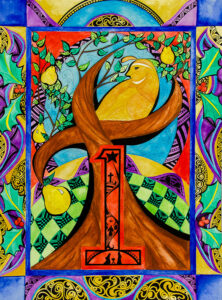It has long been recognized that a simple Christmas carol has the power to instruct, remind, and inspire. For centuries historic churches have worshipped using a unique holiday service called Lessons and Carols to teach the nativity narrative to their congregants.
Though most modern holiday songs focus on the fun and fantastical characters of the season, the enduring theology of the old Christmas carols still freely mingles in the winter air of the season.
However, among these songs of older origins, there is one that admittedly causes us to stop and scratch our heads—“The Twelve Days of Christmas,” a jumbled cacophony of fruit, foul, and finery leading to occasions of leaping, dancing, and lively acts. Why has this song become a beloved seasonal standard? Does it also contain indications of the Gospel message?
As a visual artist who works with liturgical symbolism, I found myself asking these questions while preparing for my most recent series, “Of Christmas & Catechism: A Journey Through the 12 Days of Christmas.”
What I discovered is that sadly there is much about the song that has not been recorded and therefore remains shrouded in mystery. Let’s take a moment to evaluate what we can safely rely on, what seems unlikely, and how these elements can be blended together as a tool for family worship.
The twelve days are significant and indicate a religious past. Many today connect the mention of multiple days with an attentive act of Christmas gift giving. However, historically the twelve days represent the time between the date of Christ’s incarnation as an infant in the manger and the date when the Magi knelt before the toddler acknowledging his royal right as the King of Kings. Therefore, the twelve days are those between the holidays of Christmas and Epiphany. During the Middle Ages, these twelve days were celebrated as a holy time of daily services, renewal, and re-dedication. Sometimes small gifts were given to children as reminders of faith; this supports the idea of gift giving in the current version of the song.
But there is still much confusion regarding the meaning of the words. Some have stated that they reflect pagan feast rituals; others suspect aspects of normal English life; and some indicate that they were arranged as part of a memory game. To complicate things, the last four or five days have regularly changed places as the song has evolved to its current state.
What first attracted me to the twelve days as an art subject was a tale of a hidden code, a catechism, embedded within the lyrics. It was supposed that when Catholicism became an illegal practice in sixteenth-century England, the clerics of the church invented a hidden system of teaching through the use of music, so the basic tenants of their faith were spread. Also “The Twelve Days of Christmas” supposedly connected certain numbers with aspects of biblical instruction. Numerical designations have long been used to teach truth within the historic church.
However, overall, the theory is lacking in substantial evidence. While several respected contemporary Christian authors have written affirmatively in defense of this theory, overall older sources remain mute on any religious connection. As far as I was able to ascertain, the earliest recorded mention of this teaching began no earlier than 1979 when a Canadian hymnologist, Hugh D. McKellar, published an article called, “How to Decode the Twelve Days of Christmas.” Unfortunately, his theory and that of those who have followed closely in his footsteps remains unverifiable.
While there is much to appreciate about the idea of “The Twelve Days of Christmas” as a catechism, how can we continue to teach an idea to our children that we know to be untrue? As a Christian, the last thing I want to do is create a revisionist history lesson. Yet, is there something this song can offer the faith-following family of today?
I believe the answer is yes. While it is unlikely that “The Twelve Days of Christmas” was a catechism, there is nothing to say that it cannot become one. When we tell our children about Christmas, we usually begin just before the stable and end just after the manger. In this way we make the birth of Jesus the beginning and ending event. Yet, He came as an unexpected King on His way toward victory; the Fulfiller of past prophesies and Redeemer of souls. Shouldn’t we then be taking the time to tell our kids the rest of the story at Christmas? I believe the answer is yes and that “The Twelve Days of Christmas” offers us a way to incorporate catechistic truth into our holiday—holy day—celebration.
Loosely based on formerly published assumptions, here are some biblical associations you may want to use as conversation starters within your own family. Begin with equating the true love with God. As the Giver of “every good and perfect gift” (James 1:17), we remember all God has given us in order that we may know Him and grow in Him day by day.
 Day 1 – The partridge may be seen as Jesus Christ (John 3:16).
Day 1 – The partridge may be seen as Jesus Christ (John 3:16).
Day 2 – The two turtle doves could reminds us of Adam and Eve (Genesis 2:18-22) or the Old and New Testaments (2 Timothy 3:16).
Day 3 – The three French hens might represent the three virtues of faith, hope, and love (1 Corinthians 13:13).
Day 4 – The four collie/calling birds could be seen as the four evangelists or the four gospels (Matthew, Mark, Luke and John).
Day 5 – The five golden rings may remind us of the richness of God’s law found in the Hebrew Torah (Genesis, Exodus, Leviticus, Numbers and Deuteronomy).
Day 6 – The six geese laying might be the six days of Creation (Genesis 1).
Day 7 – The seven swans swimming could be seen as the seven gifts of the Holy Spirit (1 Corinthians 12:7-11).
Day 8 – The eight maids milking reminds us of the eight beatitudes (Matthew 5:1-12).
Day 9 – The nine ladies dancing might represent the nine fruits of the Spirit (Galatians 5:22-23).
Day 10 – The ten lords leaping reminds us of the ten commandments (Exodus 20:1-17).
Day 11 – The eleven pipers piping could be the eleven faithful apostles listed in the Gospels.
Day 12 – The twelve drummers drumming could represent the twelve points of doctrine in the Apostles Creed, the twelve tribes of Israel, or the twelve apostles.
©2018 Jeremy P. Miller



